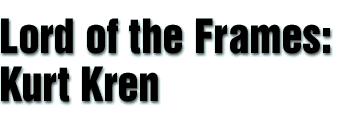|
 |
||
|
Peter Tscherkassky pays tribute to the Austrian artist and avant garde filmmaker |
In 1964 ‘Wien Film’ - refused to print 6/64 Mama und Papa. When Kurt Kren handed in the original, the film grader said with an undertone of sympathy that, given the many cuts, one would not be able to make out anything, anyway. His worries were groundless: when Kren came to pick up the print, some people with flushed faces left the projection room, telling him to get out and never to come back again. A few months later, a similar scene took place at ‘Listo’ where 9/64 0 Tannenbaum was not accepted. Kren ultimately found a place that took his films, based on actions by Otto Muhl and Gunter Brus: a house on Peter Kaiser-Gasse in Jedlersdorf, a neighborhood in the East of Vienna, on the other side of the river Danube. There, in the 21st district, on the most remote outskirts of town, films were developed and printed in self-made contraptions reminiscent of washing-machine drums. The man who ran the business single-handedly intimated that he was used to explicit images owing to customers from the blue movie scene. The facts that the credits in a few Kren works from those days are slightly out of place and that the name "Kren", next to the copyright sign goes beyond the edge of the frame can be explained in this context. On request, credits were in-house productions, but they were made with a camera that had no viewfinder, for which reason slipped boards were none too unusual. There were no objections to the films’ content, formal and creative issues played a secondary role.
Be that as it may, the ‘© Kren’ jutting out over the frame can easily be understood as a metaphor of the avant-garde and a harbinger of cinema outside the screen Expanded Cinema. It is precisely during the ‘Jedlersdorf period’ in his oeuvre that Kurt Kren demonstrates some of its best knacks to modern cinematography.
In his essay ‘On the question of form’ dating from 1972, Wassily Kandinsky proclaimed that the ‘Great Abstraction’ and ‘Great Realism’ were equivalent. Kandinsky’s text marks the acme of a development in Western art that started in the late Middle Ages and can be followed stringently ever since the Renaissance. It is a development that oscillates between two polarities: on the one hand, there is a type of painting that sets aspects of form and composition aside to depict nature as accurately as possible, on the other hand, there is the opposite type of painting that strives for the strict adherence to formal principles in all its idealizing styles. This longing for a lofty reproduction of reality, which concurrently seeks to express that which is hidden behind the appearances, unites a great variety of styles and artists, such as idealizing Classicism, Gauguin. Expressionism and Mondrian’s extreme formalization of the phenomenal world along the same lines of visual development.
Kandinsky deals with what he calls the other genealogy of modern art which is based on ‘realistic’ art striving to depict everything true to nature. However, when it turns away from space to represent the moment as we perceive it, it introduces the component of time into the structure of the picture, something reflected in the light application of paint, in sketchy freehand drawings: objects become volatile. The immanent renunciation of form found in Naturalism (the reproduction of phenomena the way they appear) eventually leads - via Impressionism - to a two-pronged approach ending in the disintegration of form: in Kandinsky’s free abstraction and in the extreme realism of the ready-made and comparable collages of objects from the workshops ofthe Dadaists. The Great Abstraction foregoes the mediation of the perceptual world and represents the Creative media themselves; the Great Realism foregoes representation. substituting for it the object itself.
To put it in a nutshell the names Kandinsky, Mondrian and Marcel Duchamp map out the terrain wherein twentieth Century art is located. As we all know, the aesthetic issues at stake in the conflicts between these positions in the visual arts also come to bear on cinematography with some delay. Their impact is all the more tremendous, and Kurt Kren’s contribution in this context is no less than outstanding, from a global perspective. too...
Translation: Elisabeth Frank-Großebner
Full article published in Filmwaves - Issue 8, Summer 1999. Subscribe now!

